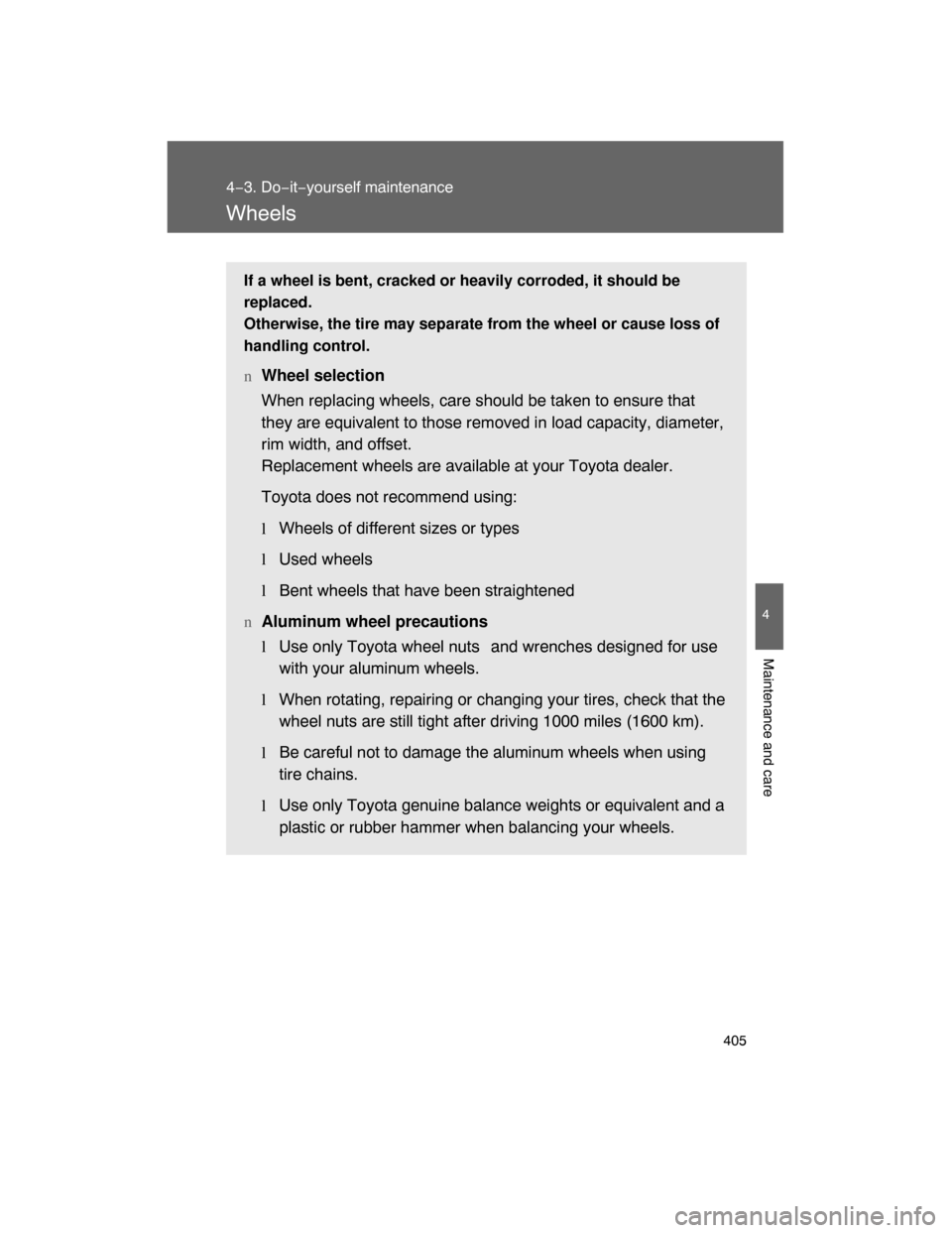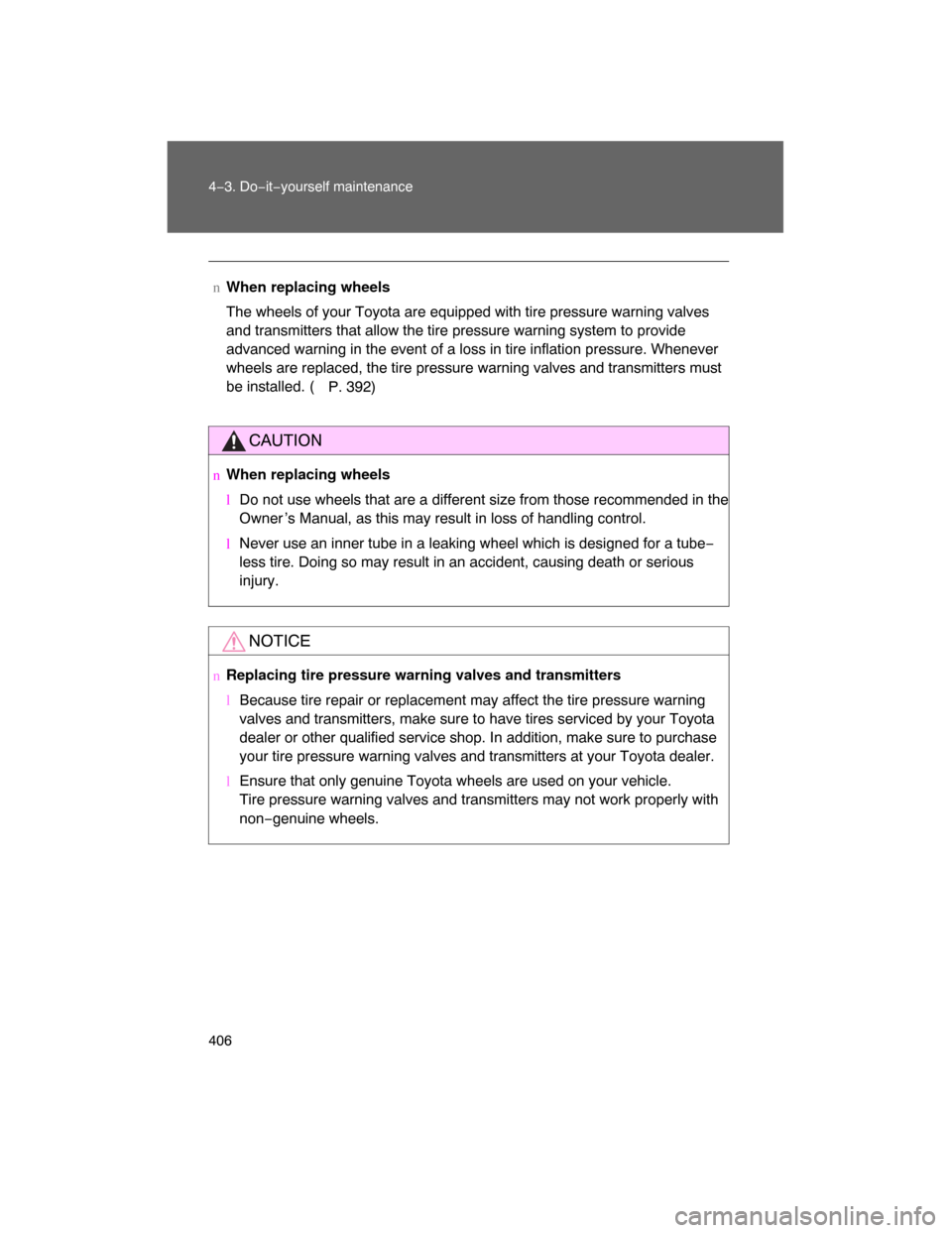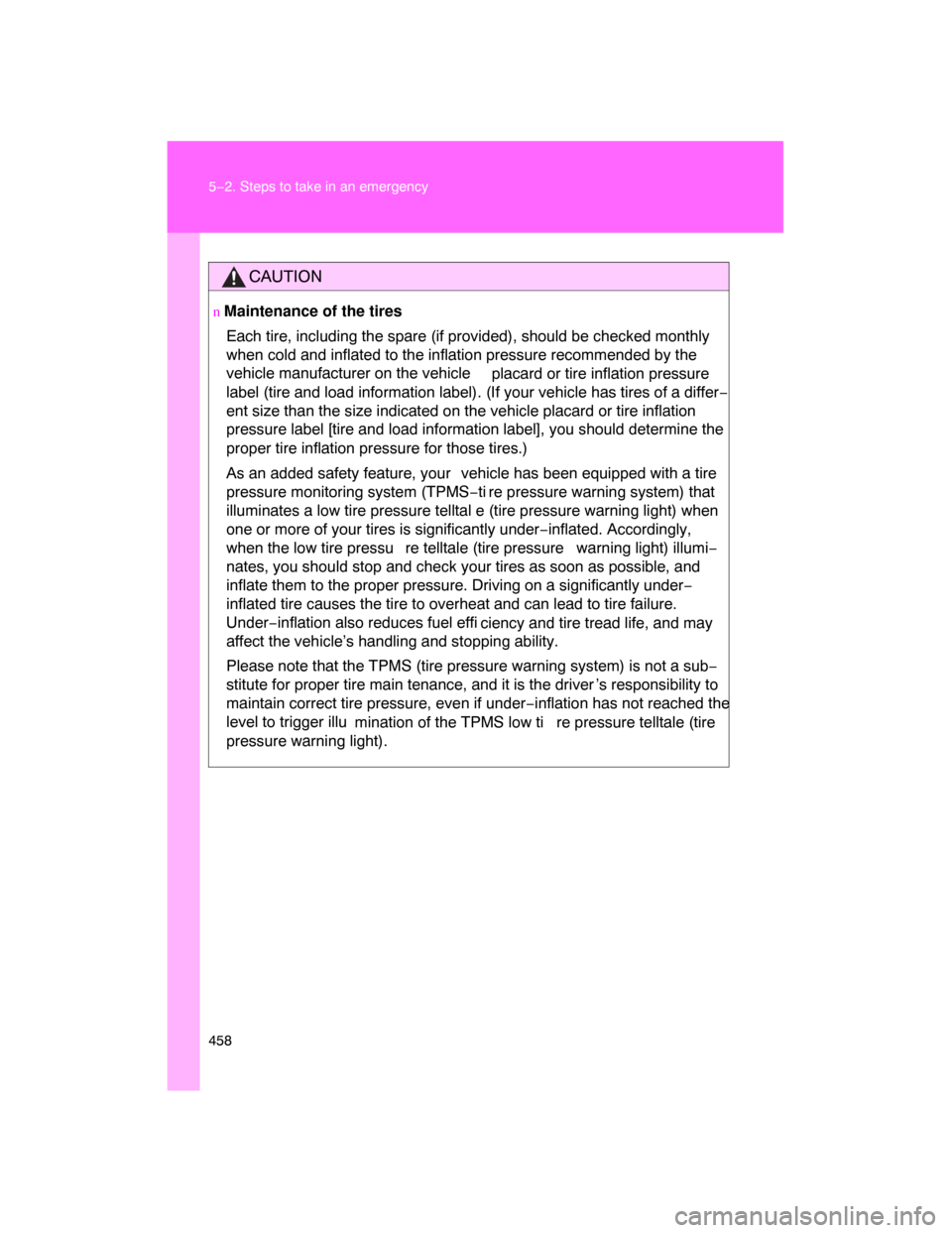Page 396 of 531
401
4−3. Do−it−yourself maintenance
4
Maintenance and care
Tire inflation pressure
nTire inflation pressure
The recommended cold tire inflation pressure and tire size is dis−
played on the tire and loading information label. (
P. 502)
TIRE SIZECOLD TIRE PRESSUREPXXX/XXRXX
PXXX/XXRXXXXXkPa,XXPSI
XXXkPa,XXPSI
XXXkPa,XXPSI
PXXX/XXRXXPXXX/XXRXX
PXXX/XXRXX
PXXX/XXRXXXXXkPa,XXPSI
FRONT
REAR
SPAREPNEUSDIMENSIONPRESSION
GONFLAGE A FROIDDEXXXkPa,XXPSI
XXXkPa,XXPSI AVA N TARRIERESECOURS
TIRE
SEE MANUAL
ADDITIONAL INFORMATIONFOR OWNER’S
AND LOADINGSEATINGTheand cargo should never exceed XXX XXXkg lbs.orcombined weight occupantsofCAPACITY TOTAL
FRONT
POUR
VOIR
LE DUMANUEL PROPRIETAIREDEPLUS AMPLES INFORMATIONS,
REARINFORMATIONINFORMATION
NOMBRE
Le
doit jamais etre a kg lb.ouXXX XXXsuperieur poids totaldes et du nechargementoccupantsDE PLACES ASSISESTOTAL X
AVA N T XARRIEREXSUR LES ET LEPNEUSCHARGEMENTXXX
ITY43C072
Page 400 of 531

405
4−3. Do−it−yourself maintenance
4
Maintenance and care
Wheels
If a wheel is bent, cracked or heavily corroded, it should be
replaced.
Otherwise, the tire may separate from the wheel or cause loss of
handling control.
nWheel selection
When replacing wheels, care should be taken to ensure that
they are equivalent to those removed in load capacity, diameter,
rim width, and offset.
Replacement wheels are available at your Toyota dealer.
Toyota does not recommend using:
lWheels of different sizes or types
lUsed wheels
l
Bent wheels that have been straightened
n
Aluminum wheel precautions
l
Use only Toyota wheel nuts and wrenches designed for use
with your aluminum wheels.
l
When rotating, repairing or changing your tires, check that the
wheel nuts are still tight after driving 1000 miles (1600 km).
lBe careful not to damage the aluminum wheels when using
tire chains.
lUse only Toyota genuine balance weights or equivalent and a
plastic or rubber hammer when balancing your wheels.
Page 401 of 531

406 4−3. Do−it−yourself maintenance
nWhen replacing wheels
The wheels of your Toyota are equipped with tire pressure warning valves
and transmitters that allow the tire pressure warning system to provide
advanced warning in the event of a loss in tire inflation pressure. Whenever
wheels are replaced, the tire pressure warning valves and transmitters must
be installed. (
P. 392)
CAUTION
nWhen replacing wheels
lDo not use wheels that are a different size from those recommended in the
Owner ’s Manual, as this may result in loss of handling control.
lNever use an inner tube in a leaking wheel which is designed for a tube−
less tire. Doing so may result in an accident, causing death or serious
injury.
NOTICE
nReplacing tire pressure warning valves and transmitters
lBecause tire repair or replacement may affect the tire pressure warning
valves and transmitters, make sure to have tires serviced by your Toyota
dealer or other qualified service shop. In addition, make sure to purchase
your tire pressure warning valves and transmitters at your Toyota dealer.
l
Ensure that only genuine Toyota wheels are used on your vehicle.
Tire pressure warning valves and transmitters may not work properly with
non−genuine wheels.
Page 452 of 531

458 5−2. Steps to take in an emergency
CAUTION
n Maintenance of the tires
Each tire, including the spare (if provided), should be checked monthly
when cold and inflated to the inflation pressure recommended by the
vehicle manufacturer on the vehicle
placard or tire inflation pressure
label (tire and load information label). (If your vehicle has tires of a differ−
ent size than the size indicated on the vehicle placard or tire inflation
pressure label [tire and load information label], you should determine the
proper tire inflation pr
essure for those tires.)
As an added safety feature, your
vehicle has been equipped with a tire
pressure monitoring system (TPMS−ti re pressure warning system) that
illuminates a low tire pressure telltal e (tire pressure warning light) when
one or more of your tires is significantly under−inflated. Accordingly,
when the low tire pressu
re telltale (tire pressure warning light) illumi−
nates, you should stop and check your tires as soon as possible, and
inflate them to the proper pressure. Driving on a significantly under−
inflated tire causes the tire to overheat and can lead to tire failure.
Under−inflation also reduces fuel effi
ciency and tire tread life, and may
affect the vehicle’s handling and stopping ability.
Please note that the TPMS (tire pressure warning system) is not a sub−
stitute for proper tire main tenance, and it is the driver ’s responsibility to
maintain correct tire pressure, even if under−inflation has not reached the
level to trigger illu
mination of the TPMS low ti re pressure telltale (tire
pressure warning light).
Page 495 of 531
502 6−1. Specifications
Tires and wheels
Tire sizeP285/60R18 114V
Tire inflation pressure
(Recommended cold tire
inflation pressure)Normal driving
Front tires:
33 psi (230 kPa, 2.3 kgf/cm
2 or bar)
Rear tires:
33 psi (230 kPa, 2.3 kgf/cm
2 or bar)
Spare tire:
33 psi (230 kPa, 2.3 kgf/cm
2 or bar)
Trailer towing
Front tires:
33 psi (230 kPa, 2.3 kgf/cm
2 or bar)
Rear tires:
33 psi (230 kPa, 2.3 kgf/cm
2 or bar)
Spare tire:
33 psi (230 kPa, 2.3 kgf/cm
2 or bar)
Wheel size 18
8 J
Wheel nut torque
97 ft�lbf (131 N�m, 13.4 kgf�m)
Page 501 of 531
508 6−1. Specifications
Typical DOT and tire identification number (TIN)
DOT symbol
*
Tire Identification Number
(TIN)
Tire manufacturer ’s identifica−
tion mark
Tire size code
Manufacturer ’s optional tire
type code (3 or 4 letters)
Manufacturing week
Manufacturing year
*:The DOT symbol certifies that
the tire conforms to applicable
Federal Motor Vehicle Safety
Standards.
Maximum cold tire inflation pressure ( P. 512)
This means the pressure to which a tire may be inflated.
TUBELESS or TUBE TYPE
A tubeless tire does not have a tube and air is directly filled in the
tire. A tube type tire has a tube inside the tire and the tube main−
tains the air pressure.
Radial tires or bias−ply tires
A radial tire has RADIAL on the sidewall. A tire not marked RADIAL is a
bias−ply tire.
ITY61C014
DOT EUJX JIS0103
Page 502 of 531
509
6−1. Specifications
6
Vehicle specifications
Tire size
nTypical tire size information
The illustration indicates typical
tire size.
Ti r e u s e
(P = Passenger car,
T = Temporary use)
Section width (millimeters)
Aspect ratio
(tire height to section width)
Tire construction code
(R = Radial, D = Diagonal)
Wheel diameter (inches)
Load index (2 or 3 digits)
Speed symbol
(alphabet with one letter)
nTire dimensions
Section width
Tire height
Wheel diameter
P285/60R18 11 4V
ITY61C011
ITY61C012
Page 506 of 531

513
6−1. Specifications
6
Vehicle specifications
Tire related term Meaning
Normal occupant
weight150 lb. (68 kg) times the number of occupants
specified in the second column of Table 1
* that
follows
Occupant distributionDistribution of occupants in a vehicle as speci−
fied in the third column of Table 1
* below
Production options
weightThe combined weight of installed regular pro−
duction options weighing over 5 lb. (2.3 kg) in
excess of the standard items which they
replace, not previously considered in curb
weight or accessory weight, including heavy
duty brakes, ride levelers, roof rack, heavy duty
battery, and special trim
RimA metal support for a tire or a tire and tube
assembly upon which the tire beads are seated
Rim diameter
(Wheel diameter)Nominal diameter of the bead seat
Rim size designation Rim diameter and width
Rim type designationThe industry manufacturer ’s designation for a
rim by style or code
Rim width Nominal distance between rim flanges
Vehicle capacity
weight (Total load
capacity)The rated cargo and luggage load plus 150 lb.
(68 kg) times the vehicle’s designated seating
capacity
Vehicle maximum load
on the tire
The load on an individual tire that is determined
by distributing to each axle its share of the
maximum loaded vehicle weight, and dividing
by two